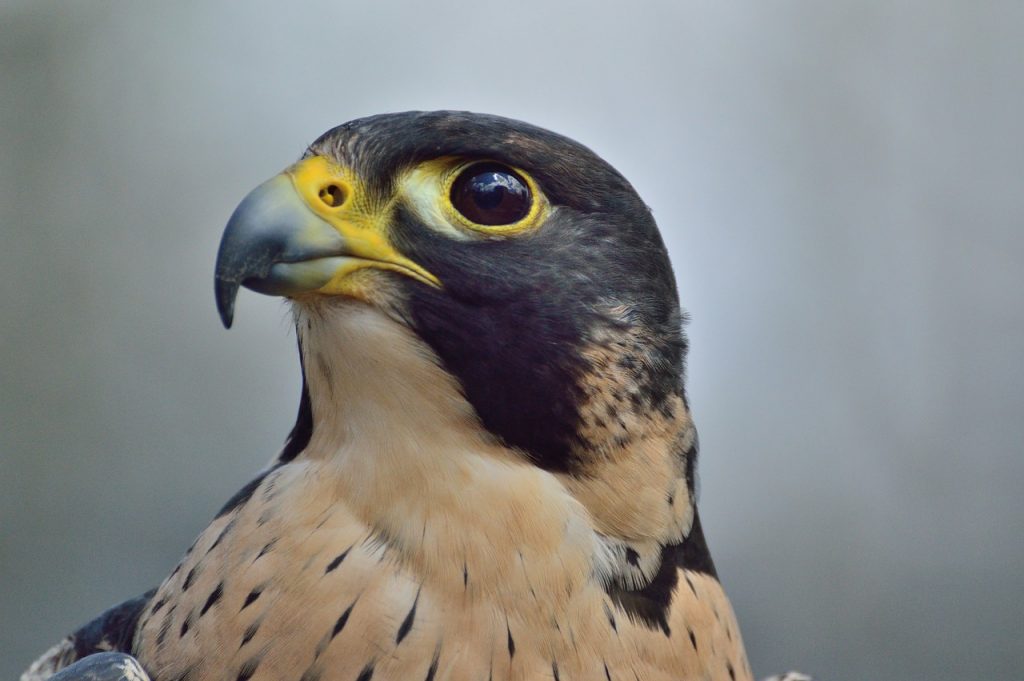
Known as one of the fastest fliers in the world, the Peregrine Falcon is a world-class go-getter.
Whether it’s nesting on cliffs at elevations up to 12,000 feet or taking down prey from small songbirds and bats to the occasional sandhill crane (say whaaa!?), there isn’t much this crow-sized champ can’t achieve.
Most of us have aspirations in our lives, whether it’s related to our health, career, relationships, or wanting more time to experience the things we enjoy.
But we’re easily stuck in defining exactly what they are or how to implement the actionable steps to achieve them.
If you’re in such a place – feeling stuck & uncertain about where to start – fortunately you’ve come to the right place. Because this whizbang raptor may be one of the best mentors on the planet when it comes to identifying & knocking out your goals one by one.
First things first
Before we get started, it pays to understand one of the peregrine’s strategies when it comes to achieving its goals – namely their goal of taking down prey.
While they may charm you with their large brown eyes & feisty calls, their beauty & grace belies the reality of this sinister sky demon.
(insert evil falcon laugh here…)
That’s right – one of the secrets behind the peregrine’s success is not only hunting at incredible speeds, but doing so with a balled-up fist.
Move over, Butterbean
People pay hundreds of millions per year to watch other human beings pummel the piss out of each other – but if they only knew what greatness lied outside their door.
While you may have surmised that a balled falcon fist + 200mph + a bird skull = lights out, it’s far more complicated than terrorizing the sky with brute strength.
Rather, it’s their combination of agility, speed & strength that accounts for their success.
The Nitty Gritty
First, let’s go nerd-o-rific by dissecting some quick & admittedly simplified details about the Peregrine’s hunting scheme – unless you want to get specific & be subjected to flashbacks of geometry like:
γ˙(t)=Nλ˙(t)
with results explaining:
“The effective navigation constant is defined as N′ = N(vcosδ)/vc, where vc is the speed at which the attacker closes range on its target. Hence, since vc = vcosδ by definition when the target is stationary, it follows that PN guidance with N = 3 will produce the most efficient trajectory possible in terms of the control effort needed to hit a stationary target.”
See what I mean? In this case, simple will do – and it’s all we need to illustrate the point.
So – let’s dive in, shall we…?
At kick-off, these agile assassins will choose a high perch or soar at landscape-level heights to allow for best viewing. After something’s caught their eye, it’s time for a closer inspection.
First, they have to choose an individual to put on lock down.
The individual may be obvious if there’s a lone wolf that’s made itself an easy target. But when a flock of dozens if not hundreds of birds is shuttling across the sky, falcons aren’t flapping willy nilly hoping to nab whatever wackadoo happens to flutter too close to its talons.
Rather, their style is precise. So precise that it’s exactly what engineers have developed for guided missiles, which use parallel or proportional navigation to hone in on their target.
Despite what was previously believed, falcons don’t appear to be calculating both their own speed & direction relative to that of their prey in order to intercept them.
Rather, they need only track how the pathway is changing between themselves & their prey to gauge the trajectory needed to make their terminal attack.
Now, that’s already a decent amount of math – all in the midst of some hella strenuous activity – but they’re not done yet.
During their final “stoop” – or hunting dive – falcons can reach speeds of up to 150 to 200 mph to close the gap. As they collide with their prey, they may grab it mid-air or hit it with their fist to knock it out.
If prey is caught in its talons, the falcon will return to a perch or ground to dispatch it. If it’s been hit, it will fall to the ground before its lights out via one final bite through the neck.
Then it’s time for pluckin’ & eatin’ (after a brief rest, of course).
How successful are they?
When pondering the Peregrine, one final question remains: if these feathered missiles are one of the fastest fliers on the planet, surely they must be batting a thousand?
And for all of their strength, speed & agility, you’d think so – but you’d be wrong.
Because even these superheroes strike out.
It depends heavily upon circumstances – including season, location, sex & species they’re hunting – but success rates have been reported to vary from 7 to 83%. One male in the Eastern U.S., however, was observed to have a 93% success rate hunting Blue Jays.
Their tools & endurance are top-notch, and the more experienced they are in life & on the landscape, the more likely they are to be successful. But – and I can’t emphasize this point enough – even these BAMFs aren’t strutting victorious every time.
How you can apply their strategy to your own life
Now that we’ve reviewed the Cliff’s Notes to Hunting Like A Peregrine, you might be wondering how you can use their strategies to your advantage.
Well ponder not, dear friend, because here are the top three takeaways that make these birds so successful & how we can apply them to pursuing our own goals.
1. Choose a single goal to pursue

We often think there aren’t enough hours in the day to achieve all of our goals. But as Seth Godin once noted, “you don’t need more time, you just need to decide.”
Falcons don’t wantonly throw themselves into a flock of ducks grasping haphazardly. Rather, their advantages of speed & agility only apply because they focus on one single goal (i.e. bird) at a time.
And when they focus on one bird, they necessarily can’t focus on the dozen or more birds in the rest of the flock.
In much the same way, it can be an uncomfortable truth to accept that you need to focus on a single goal at the expense of others, particularly when many a guru is lining their pocket telling you that you can “have it all.”
But here’s a reality check straight from the Chronicles of Falco Peregrinus: you can’t.
It doesn’t mean that you have to ditch all of your goals – it only means you have to triage them & focus on the one that’s most important to accomplish right now.
2. Lock onto your target…but be flexible
Peregrines don’t waste time fiddly fussin’ around – they know what they’re after & when they find it, it’s all systems go.
But what’s important to note is that they’re locked onto the target – not the path.
The path will help them reach their prey, and while it needs to be specific, it also must be flexible.
When you’re working to achieve your goal, it isn’t enough to have passion – you have to forge a plan.
If you’re looking to start a business – what are your strengths? who is your audience? What are their needs? How are you planning to help them address those needs? What will you offer? How will you reach them? Are they willing to pay for your product?
And this list is just the pocket-sized version of the encyclopedia of questions you’ll need to ask yourself before (and while) you take that leap.
If it just so happens that you have another goal – find another job, move to another city, earn another degree – the point is the same. You’ll need to map out a plan to achieve it, but….
As you well know, life rarely adheres to your precise plans – and you can’t be so married to a specific process that you forget the end goal.
Speaking of life not adhering to your plans…
3. Get used to failure
Remember those hunting success rates? The ones that weren’t 100%?
Yeah, those.
When you’re pursuing a goal, you’ll have to accept that failure is an inevitable part of the process.
You’ll hear no. You’ll have doors slammed in your face. You’ll have rugs ripped out from under you. You’ll struggle & wonder why the hell you ever bothered with any of this nonsense in the first place.
It matters not what goal you pursue – only that you accept there is no immunity to failure & rejection.
Because if you haven’t felt it already, I guarantee it will chase you down like a fuming nest of yellow jackets you just mowed over in the backyard.
And with every “no” & herculean sting of rejection, you’ll teeter on the edge of caving in.
The question is: are you strong enough to adjust your sails & keep going?
Take-home
Given their speed, making near-perfect decisions is paramount. One miscalculation & they may not only miss a meal, but risk injuring or even dispatching themselves in the process.
Fortunately, our choices aren’t often so precarious.
But they can leave us feeling stumped, stymied & stuck – trapped in the quicksand of our own uncertainty & inability to move forward.
While every wannabe guru is happy to “help” while charging a leg & a wing to tell you about the “Law of Attraction,” Peregrines are out there living life like a boss, doling out some of the best life advice you can find.
The best part? It’s all for free.
The toughest part? You have to know when to slow down & listen – and prepare to mow over some yellow jackets.